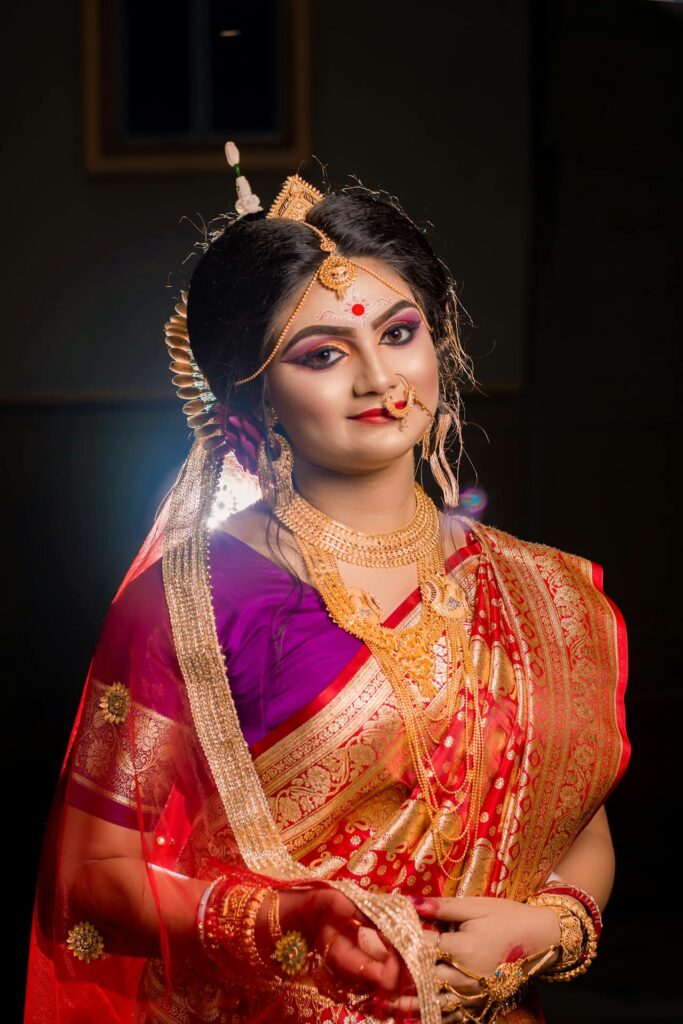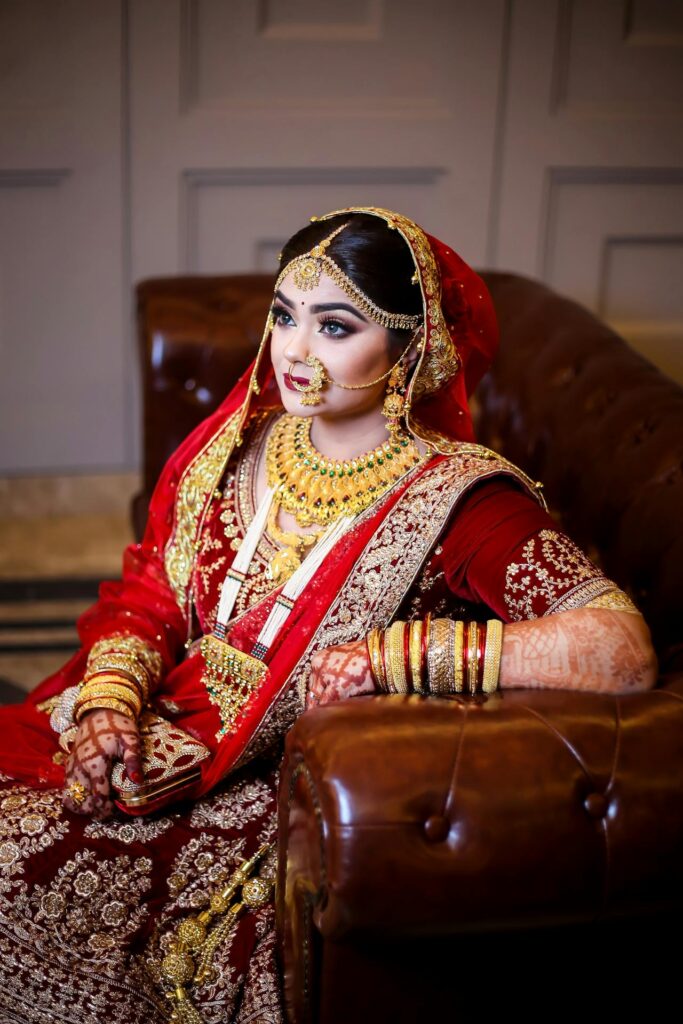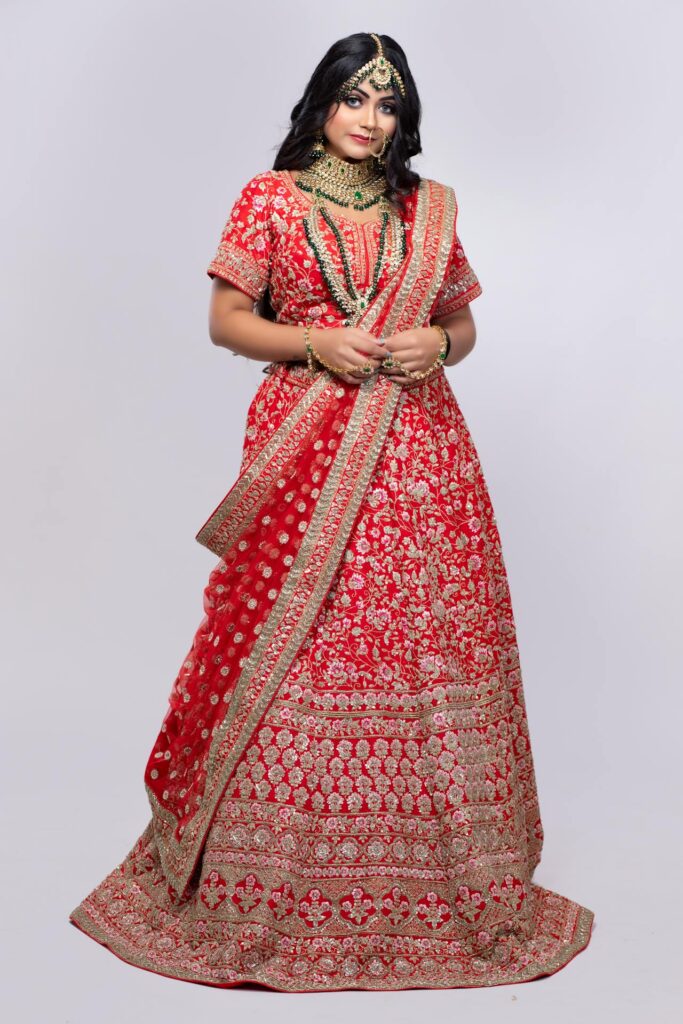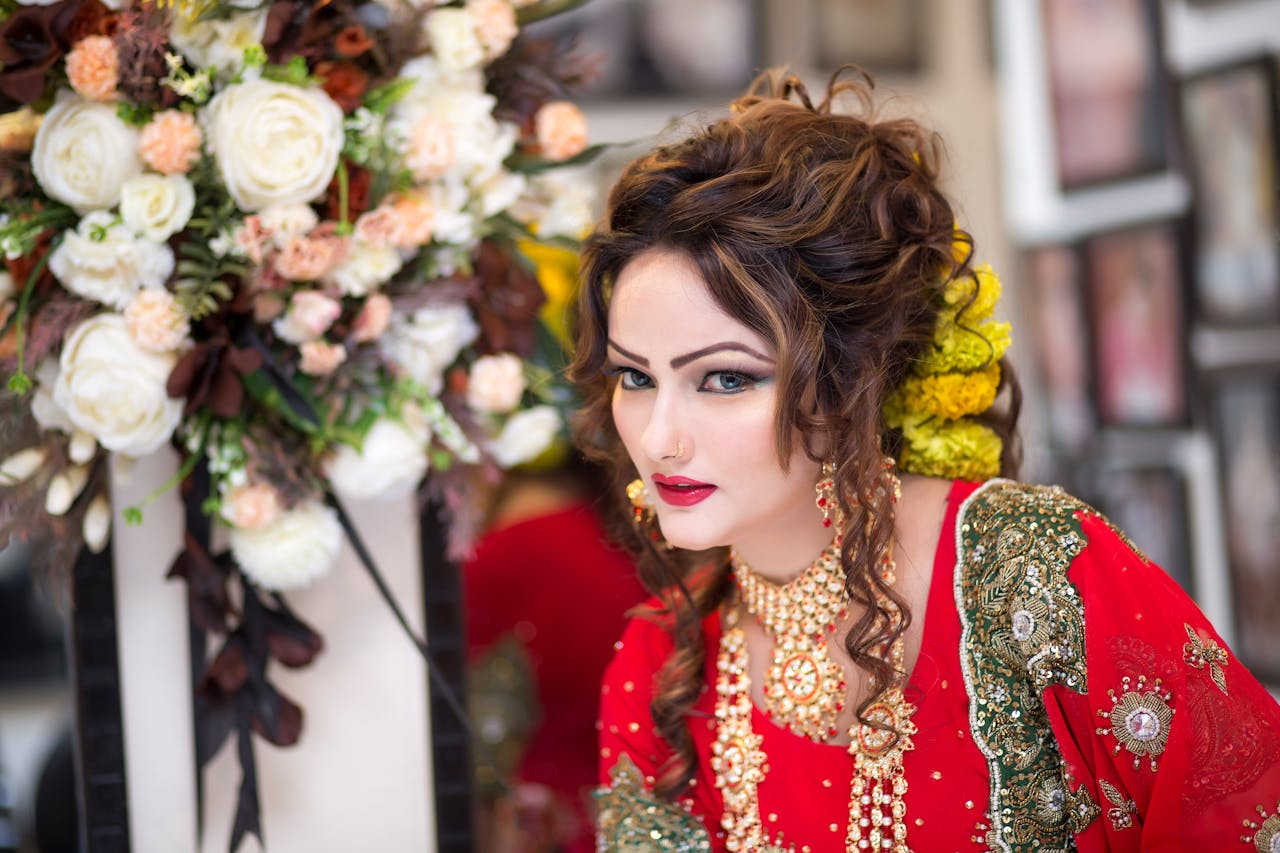Indian weddings are known for their grandeur, vibrant colors, and intricate traditions. One of the most captivating aspects of these celebrations is the stunning array of wedding dresses. Indian style wedding dresses are a perfect blend of tradition, elegance, and modernity, making them a popular choice not just in India, but worldwide. In this comprehensive guide, we will explore various types of Indian style wedding dresses, their unique features, and how to choose the perfect one for your big day.
Table of Contents
Types of Indian Wedding Dresses
Indian wedding attire is incredibly diverse, reflecting the country’s rich cultural heritage. Here are some of the most popular types of Indian wedding dresses:
1. Saree
The saree is a timeless classic in Indian wedding attire. It consists of a long piece of fabric, usually around six to nine yards, that is draped around the body in various styles. Wedding sarees are often made from luxurious materials like silk, adorned with intricate embroidery, beadwork, and sequins.
Popular Styles of Sarees:
- Kanjeevaram Silk Sarees: Known for their rich colors and gold zari work, these sarees originate from Tamil Nadu.
- Banarasi Sarees: Hailing from Varanasi, these sarees are famous for their brocade work and opulent designs.
- Patola Sarees: These are double ikat woven sarees from Gujarat, known for their geometric patterns and vibrant colors.
2. Lehenga Choli

A lehenga choli is a two-piece outfit consisting of a long skirt (lehenga) and a fitted blouse (choli). It is often paired with a dupatta (a long scarf) draped elegantly over the shoulder. Lehengas are highly embellished with embroidery, sequins, and mirror work, making them a dazzling choice for brides.
Popular Styles of Lehengas:
- A-Line Lehenga: Fits at the waist and flares out to the hem, resembling the letter ‘A’.
- Mermaid Lehenga: Fits tightly from the waist to the knees and then flares out like a fishtail.
- Circular Lehenga: Has a broad flare and forms a complete circle when spread out.
3. Salwar Kameez
A salwar kameez consists of a tunic (kameez) paired with trousers (salwar) and a dupatta. While traditionally worn as everyday attire, it has evolved into an elegant wedding outfit with the addition of rich fabrics and ornate embellishments.
Popular Styles of Salwar Kameez:
- Anarkali Suits: Characterized by their long, frock-style tops and slim fitted bottoms.
- Punjabi Suits: Feature a short kameez and baggy salwar, known for their comfort and vibrant designs.
- Palazzo Suits: Pair wide-legged palazzo pants with a straight-cut kameez.
4. Anarkali
Anarkali suits are another popular choice for weddings. They consist of a long, flowing kurta that flares out from the waist, resembling a gown. These suits are often adorned with heavy embroidery, sequins, and other decorative elements, making them perfect for a grand celebration.
Popular Styles of Anarkali:
- Floor-length Anarkali: Extends to the floor, giving a regal look.
- Jacket Anarkali: Comes with a stylish jacket, adding a contemporary touch to the traditional outfit.
- Cape Anarkali: Features a cape instead of a dupatta, offering a modern twist.
Bridal Jewelry and Accessories
- Tika: Forehead ornament.
- Nath: Nose ring.
- Choodiyan: Bangles.
- Payal: Anklet.
- Kamarband: Waistband.
- Hathphool: Hand jewelry.
Regional Variations
- North India: Lehengas and sarees with heavy embroidery and gold jewelry.
- South India: Kanjeevaram sarees, temple jewelry.
- East India: Assam silk sarees, traditional Manipuri and Bengali sarees.
- West India: Bandhani sarees, Gujarati lehengas.
Modern Trends
- Fusion Wear: Combining traditional elements with contemporary styles.
- Minimalistic Designs: Subtle embroidery and light fabrics.
- Eco-Friendly Materials: Sustainable fabrics and natural dyes.
Tips for Choosing the Perfect Indian Wedding Dress
- Body Type: Choose a style that flatters your body shape.
- Comfort: Ensure the dress is comfortable to wear for long hours.
- Theme: Coordinate with the wedding theme and decor.
- Season: Consider the season and weather when choosing fabrics and colors.
- Budget: Plan according to your budget, as wedding dresses can be quite expensive
How to Choose the Perfect Indian Wedding Dress

Choosing the right wedding dress is a crucial decision for any bride. Here are some factors to consider:
1. Body Type
Different styles of dresses suit different body types. For instance, an A-line lehenga is flattering for most body types, while a mermaid lehenga is best for brides with an hourglass figure.
2. Wedding Theme
The theme of your wedding can influence your choice of attire. A traditional temple wedding might call for a classic Kanjeevaram saree, while a modern, outdoor wedding might be better suited to a contemporary lehenga.
3. Comfort
While it’s important to look stunning, comfort should not be compromised. Ensure that the dress is comfortable to wear for long hours and allows you to move freely.
4. Budget
Indian wedding dresses can range from affordable to extremely expensive. Set a budget and stick to it, but remember that this is a once-in-a-lifetime event, so don’t be afraid to splurge a little.
Fabrics and Embellishments
The choice of fabric and embellishments plays a crucial role in the overall look of an Indian wedding dress. Here are some commonly used fabrics and decoration techniques:
Silk
Silk is a favorite for Indian wedding dresses due to its luxurious feel and natural sheen. Banarasi silk, Kanjeevaram silk, and Mysore silk are some of the most sought-after varieties.
Velvet
Velvet adds a rich and opulent touch to wedding dresses. It is often used in combination with silk to create a royal look.
Georgette and Chiffon
These lightweight and flowy fabrics are perfect for adding a touch of modern elegance. They are often used for sarees and lehengas with contemporary designs.
Embroidery
Intricate embroidery, such as zardozi, gota patti, and mirror work, is a hallmark of Indian wedding dresses. These techniques add texture and depth, making each piece a work of art.
Beadwork and Sequins
Beadwork and sequins are used to add sparkle and glamour to wedding dresses. They are often hand-sewn, ensuring that each piece is unique.
Regional Variations in Indian Wedding Dresses
India’s diverse cultural landscape is reflected in its wedding attire. Different regions have distinct styles and traditions:
North India
- Punjab: Brides often wear vibrant red or pink lehengas with heavy gold embroidery. The Punjabi bridal look is incomplete without the traditional chooda (red and white bangles) and kalire (dangling ornaments).
- Uttar Pradesh and Bihar: Banarasi silk sarees with rich brocade work are a popular choice. The sarees often feature intricate gold and silver zari (metallic thread) work.
South India
- Tamil Nadu: The Kanjeevaram silk saree is a must-have for Tamil brides. These sarees are known for their durability, vibrant colors, and elaborate zari borders.
- Kerala: Brides typically wear a white or off-white saree with a gold border, known as the Kasavu saree. The look is simple yet elegant, often complemented with gold jewelry.
West India
- Gujarat: The traditional bridal outfit is the Panetar saree, which is white with a red border, and the Gharchola, a red saree with bandhani (tie-dye) patterns and zari work.
- Maharashtra: Brides wear a Paithani saree, which is known for its unique weaving technique and vibrant colors. The saree often features motifs inspired by nature.
East India
- West Bengal: Brides wear the traditional red and white Banarasi saree. The saree is adorned with rich embroidery and is draped in a unique Bengali style.
- Assam: The Mekhela Chador is the traditional attire, consisting of two main pieces of cloth draped around the body. The silk used in these dresses is usually Muga or Pat, indigenous to Assam.
Modern Trends in Indian Wedding Dresses
While traditional styles remain popular, modern brides are increasingly experimenting with contemporary designs and fusion wear. Here are some trends that are making waves:
Pastel Shades
While red remains a classic choice, many brides are opting for pastel shades like blush pink, mint green, and powder blue. These colors offer a fresh and modern twist to traditional attire.
Minimalistic Designs
Some brides prefer minimalistic designs with subtle embroidery and light fabrics. This trend is ideal for those who appreciate understated elegance.
Fusion Wear
Fusion wear combines traditional elements with modern silhouettes. For example, a lehenga paired with a crop top or a saree with a pre-stitched pallu (the part of the saree that is draped over the shoulder).
Sustainable Fashion
With growing awareness of environmental issues, sustainable fashion is becoming popular. Many designers are using eco-friendly fabrics and ethical production methods to create beautiful wedding dresses.
Table: Comparison of Popular Indian Wedding Dress Styles
| Dress Type | Key Features | Ideal For | Popular Regions |
|---|---|---|---|
| Saree | Long fabric draped in various styles | Traditional weddings | Tamil Nadu, Varanasi |
| Lehenga Choli | Skirt and blouse with dupatta | Grand celebrations | Rajasthan, Gujarat |
| Salwar Kameez | Tunic with trousers and dupatta | Comfortable and elegant | Punjab, Haryana |
| Anarkali | Long, flowing kurta | Regal look | Pan-India |
Accessories to Complement Indian Wedding Dresses
No Indian wedding outfit is complete without the right accessories. Here are some must-haves:
1. Jewelry
Indian bridal jewelry is often elaborate and made from gold, diamonds, and precious stones. Popular pieces include necklaces, earrings, bangles, maang tikka (forehead ornament), and nose rings.
2. Footwear
Traditional juttis or mojaris are popular choices. They are often embroidered and match the bridal outfit perfectly.
3. Hairstyles and Hair Accessories
Brides often choose intricate hairstyles adorned with flowers, hairpins, and jewelry. Popular styles include buns, braids, and loose curls.
4. Henna (Mehndi)
Applying henna on the hands and feet is a traditional practice for Indian brides. The intricate designs symbolize joy, beauty, and spiritual awakening.
FAQs About Indian Style Wedding Dresses
1. What is the most popular color for Indian wedding dresses?
Red is the most traditional and popular color for Indian wedding dresses, symbolizing prosperity and fertility. However, modern brides are also opting for other colors like pink, gold, and pastels.
2. How long does it take to make an Indian wedding dress?
It can take anywhere from a few weeks to several months to make an Indian wedding dress, depending on the complexity of the design and the amount of embroidery and embellishments.
3. Can I rent an Indian wedding dress?
Yes, many boutiques and online stores offer rental options for Indian wedding dresses. This can be a more affordable option for brides on a budget.

4. How should I care for my Indian wedding dress?
Indian wedding dresses are delicate and require special care. Always follow the care instructions provided by the designer. Generally, it’s best to dry clean these outfits and store them in a cool, dry place.
5. Are Indian wedding dresses only for brides?
No, Indian wedding dresses are also available for bridesmaids, family members, and guests. There are a variety of styles and designs to choose from to suit every role in the wedding.
6. What is the significance of red in Indian wedding dresses?
Red is considered auspicious in Indian culture and symbolizes love, prosperity, and fertility. It is the traditional color for bridal wear, especially in North India.
7. Can non-Indians wear Indian wedding dresses?
Absolutely! Indian wedding dresses are celebrated worldwide for their beauty and elegance. Non-Indians are welcome to embrace these styles, especially when attending Indian weddings.
8. How do I choose the right Indian wedding dress for my body type?
It’s essential to try on different styles and see what suits your body type. For example, lehengas with high waists can elongate the body, while sarees draped in certain ways can accentuate curves.
9. What kind of jewelry goes well with Indian wedding dresses?
Traditional gold jewelry is a popular choice. Depending on the region and style of the dress, brides may also wear Kundan, Polki, or temple jewelry.
10. Where can I buy authentic Indian wedding dresses?
You can purchase Indian wedding dresses from specialized boutiques, online stores, and designers. Some renowned designers include Sabyasachi Mukherjee, Manish Malhotra, and Anita Dongre.
people also search : The Ultimate Guide to Black Punjabi Salwar Kameez: Timeless Elegance and Contemporary Style in 2024
Conclusion
Indian style wedding dresses are a beautiful blend of tradition and modernity, offering a wide range of styles and designs to choose from. Indian wedding dresses are a testament to the country’s rich cultural heritage and artistic prowess.Whether you prefer the classic elegance of a saree, the dazzling beauty of a lehenga choli, the comfort of a salwar kameez, or the regal look of an Anarkali, there is something for every bride. By considering your body type, wedding theme, comfort, and budget, you can find the perfect dress to make your special day truly unforgettable.
So, if you’re planning an Indian wedding or attending one, immerse yourself in the beauty and tradition of Indian wedding dresses, and celebrate the timeless elegance they bring to such a special occasion.
